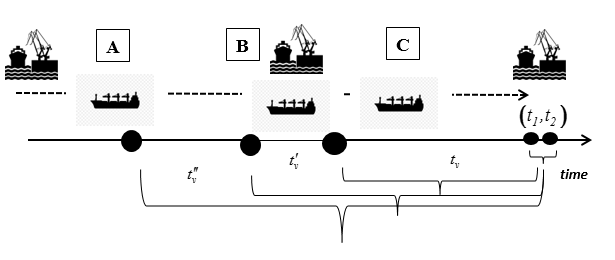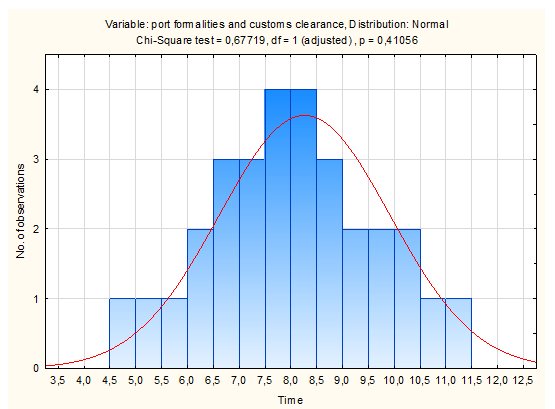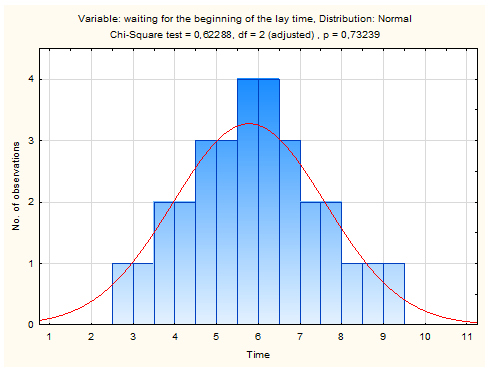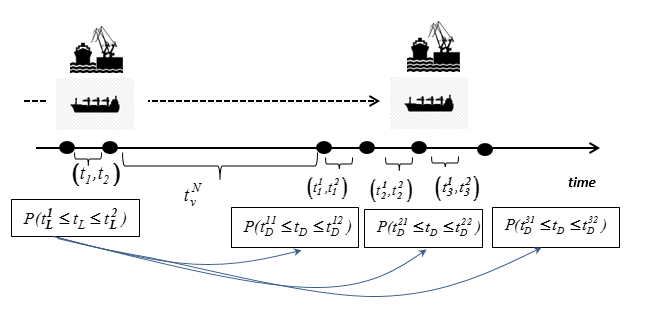ISSN
2307–3489 (Print), ІSSN 2307–6666 (Online)
Наука
та прогрес транспорту. Вісник
Дніпропетровського
національного університету залізничного
транспорту, 2019, № 1
(79)
Експлуатація
та ремонт засобів транспорту
експлуатація
та ремонт засобів транспорту
UDC
656.073.7
S.
P. ONYSHCHENKO1,
Y. A. KOSKINA2*
1Dep.
«Fleet Operating and Technologies of Sea Carriages», Odesa National
Maritime University,
Mechnikov St., 34, Odesa, Ukraine, 65029, tel.
+38 (067) 557 76 46, email onyshenko@gmail.com,
ORCID 0000-0002-9660-1921
2*Dep. «Fleet Operating and
Technologies of Sea Carriages», Odesa National Maritime University,
Mechnikov St., 34, Odesa, Ukraine, 65029, tel. +38 (067) 557 76 46,
email yuliia.koskina@ukr.net,
ORCID 0000-0002-3164-6504
ESTIMATION OF THE
TIME OF THE VESSEL'S ARRIVAL AT PORT
Purpose. The
paper aims at the assessment of the
probability of the vessel’s arrival at the port at a specified time
interval considering the different combination of the voyage
charter-party (C/P) terms and their wordings. Methodology.
The structure of the
vessel's time in port was formed considering the C/P terms and their
wordings. The time intervals for which it is actual to estimate the
time of arrival were defined
on the basis of the
theory of transport processes and systems. The
normal distribution law was used to estimate of the probability of a
vessel's arrival at a port at a specified time interval. Findings.
The probability of the vessels arrival at
the port of loading in the C/P in question was searched in three most
actual situations: 1) the vessel's opening date is known; 2) the
vessel's arrival to the port of discharging on previous C/P is known
and 3) the vessels position on the passage to the port of discharging
in previous voyage is known. For these three
situation were estimate the probability of the duration of the time
elements from the opening point and present position points
to the port of loading in the C/P in question far as the C/P terms
indicate the beginning the duration of the laytime. Originality.
For the first time the vessel's time in
port was structured considering the C/P terms and their possible
wordings, their impact on the time in port was determined, and the
probability of vessel's arrival at specified time intervals was
searched. Practical value.
The obtained results can be used in voyage planning (during
fixing the C/P and further voyage performance) by estimation the
duration of the time in port considering the C/P terms and wordings
of the beginning and duration of laytime and time of the vessel's
arrival.
Keywords:
vessel's voyage; vessel's time in port; voyage charter-party; voyage
planning
Introduction
The vessel's
time en route largely determines the duration of the passage between
ports of loading and discharging and both with the voyage
charter-party (C/P) terms on laytime (its beginning and duration) it
does the total voyage time. This time, in its turn, is a basis for
calculation of voyage expenses and that’s why it influences the
efficiency of the voyage. For the shipowner, who carries the cargo
under the voyage C/P, the
issues of determining the time of the voyage are therefore of
fundamental importance. But the most part of researches dedicated to
the voyage planning implies the problem of the time en route
indicating the slow steaming as an important factor of the voyage
efficiency [6, 7, 8, 10, 11, 14, 15]. But the time en route is only
the part of the total voyage time and it is no use of searching it
just without the time in port as far as time en route (probably the
vessel's speed on passage) determines the time of the vessel's
arrival to the port for cargo handling. Оn the other hand, the
duration of time in port depends on the appropriate terms of the
C/P.
Purpose
The purpose
of this study is the assessment
of the probability of the vessel’s arrival at the port at a
specified time interval, considering the C/P terms and their
wordings, which is quite important both for negotiations before the
C/P fixture and for voyage time planning and ensuring the voyage
efficiency when performing the voyage. In order to achieve the
purpose the following objectives are to be realized: definition
of the impact of the appropriate C/P terms and their wordings on the
structure and duration of the vessel’s time in port; determination
the situations, that
are of practical importance for assessing the probability of the
vessel arriving at a port at a specified time interval, and
obtaining the appropriate calculation formulas; conducting
statistical studies confirming the validity of using the normal
distribution law for the elements of the voyage time in the
processes of estimating
the probability of a ship arriving at
a port at a specified time
interval.
Methodology
The
definition of the impact of the appropriate
C/P terms on the structure and the duration of the vessel’s time
in port was based
on the analysis of the wording of the C/P terms and decomposition of
the time in port depending on the possible combinations of the
wordings of these terms. The determining of time intervals, for
which it is expedient to determine the probability of the vessel’s
arrival at the ports of cargo handling, was formed on the main
principles of the theory of transport processes and systems. The
estimates of the probability of a vessel arriving at a port at a
specified time interval were carried out taking into account the
properties of the normal distribution law for the elements of the
voyage time, the validity of which is confirmed by statistical
studies.
Findings
General
issues regarding the C/P terms which determine the duration of cargo
handling and appropriate vessel's time in port are stipulated in [1,
2, 3, 5, 7,
9,
12,
13,
16-18].
These terms are the loading and discharging rates, terms on Notice
of Readiness (NOR) tendering/accepting, including or excluding
Sundays and Holidays in laytime days, Sunday time duration as
itself. The initial point for time in port calculations is NOR terms
– is how it’s tendering/accepting stipulated in the C/P. There
are two main variants: 1) NOR can be tendered whether the vessel in
berth or not, whether in free pratique or not, whether in berth or
not (www) or 2) NOR can be tendered after the port formalities on
arrival, i.e. after the vessel’s berthing. Rather important are
wordings regarding the time of NOR tendering, i.e. there may be
terms in C/P according to which NOR can be tendered only during
office hours. That in fact will take some time waiting the office
hours if the vessel arrives on day off. Table 1 shows the structure
of the vessel's time in port considering the different wordings of
C/P terms. As one can see, the C/P terms determining the duration of
the elements of the time in port largely depends on the day of the
week and time of arrival (before noon of after noon). For instance,
when tendering NOR words in C/P as to be given on getting «free
pratique», the waiting time
 to tender NOR will be longer if the vessel arrives before noon (b.
n.) on day off (w/e) compared with the vessel’s arrival early in
the morning on the first working day (w. d.). Similarly, the time
between tendering/accepting of NOR will be less if the vessel
arrives before noon on working day than if she arrives, for
instance, the same day but closer to noon. If NOR can be tendered on
www terms, the formalities take place during the «grace» period
between tendering of NOR and the beginning of cargo handling. The
impact of the terms that include/exclude Sundays and holidays as
laytime is obvious. But the moment of the vessel’s arrival is also
important here – the vessel which arrived on Friday evening, for
instance, will spend more time in port if the C/P fixed on SHEx
terms than on SHInc.
to tender NOR will be longer if the vessel arrives before noon (b.
n.) on day off (w/e) compared with the vessel’s arrival early in
the morning on the first working day (w. d.). Similarly, the time
between tendering/accepting of NOR will be less if the vessel
arrives before noon on working day than if she arrives, for
instance, the same day but closer to noon. If NOR can be tendered on
www terms, the formalities take place during the «grace» period
between tendering of NOR and the beginning of cargo handling. The
impact of the terms that include/exclude Sundays and holidays as
laytime is obvious. But the moment of the vessel’s arrival is also
important here – the vessel which arrived on Friday evening, for
instance, will spend more time in port if the C/P fixed on SHEx
terms than on SHInc.
Thus, even under the same C/P
terms, which have a varying impact on the duration of time in port,
actual duration of the time in port varies and is determined by the
time of arrival of the vessel at the port. The decisive factors are:
1) The
arrival of the vessel at the port before noon (b. n.) or afternoon
(a. n.) which for NOR terms determines the initial point for
 ;
;
2) The
vessels staying in port during Sundays and holidays which (under
SHEx in the C/P) determines the
 .
.
For estimating
with reasonable certainty the possible structure and duration of
time in port, the
carrier must first assess the probability of the vessel’s arrival
at the port for cargo handling on a particular day or even within
the specified time interval of a particular day. And this, in turn,
depends on the duration of the vessel’s previous voyage and the
duration of the vessel’s passage from the last port of call (port
of loading) to the port of loading (discharging).
Thus, the estimation of the
vessel’s time in port is based on a preliminary estimation of the
duration of the previous voyage and the vessel’s passage to the
port of loading/the duration of loading and passage to the port of
discharging.
Table
1
Structure
of vessel's time in port considering on combination
of C/P terms
and wordings
|
Combinations
of
C/P
terms determining
the
vessel's time in port
|
Waiting
time

|
NOR
acceptance time

|
Formalities
time
 (arrival)
(arrival)
|
Cargo
handling time

|
Sundays
and Holidays

|
Formalities
time
 (departure)
(departure)
|
|
www
+
SHEx
|
w.d.
|
–
|
|
 incl incl

|
 incl incl

|

|

|

|
|
|
|
a.n.
|
–
|
 incl incl

|
 incl incl

|

|

|

|
|
|
w/e
|
b.n.
|
–
|
 incl incl

|
 incl incl

|

|

|

|
|
|
|
a.n.
|
–
|
 incl incl

|
 incl incl

|

|

|

|
|
www
+ SHInc
|
w.d.
|
b.n.
|
–
|
 incl incl

|
 incl incl

|

|
–
|

|
|
|
|
a.n.
|
–
|
 incl incl

|
 incl incl

|

|
–
|

|
|
|
w/e
|
b.n.
|
–
|
 incl incl

|
 incl incl

|

|
–
|

|
|
|
|
a.n.
|
–
|
 incl incl

|
 incl incl

|

|
–
|

|
|
free
pratique + SHEx
|
w.d.
|
b.n.
|
–
|

|

|

|

|

|
|
|
|
a.n.
|

|

|

|

|

|

|
|
|
w/e
|
b.n.
|

|

|

|

|

|

|
|
|
|
a.n.
|

|

|

|

|

|

|
|
free
pratique + SHInc
|
w.d.
|
b.n.
|
-
|

|

|

|
–
|

|
|
a.n.
|

|

|

|

|
–
|

|
|
w/e
|
b.n.
|

|

|

|

|
–
|

|
|
a.n.
|

|

|

|

|
–
|

|
Mathematically,
these temporal characteristics are
continually variable,
and it is possible to estimate the probabilities of one or another
range of their values given 1) knowledge of the type and parameters
of the distribution law of the above-mentioned durations of voyage
time elements; 2) the availability of reliable information on the
present position of the vessel.
A C/P is fixed
usually both during the end of cargo handling and the vessel's
opening, and much earlier. With significant
time intervals between the barging the C/P terms and the
planned beginning of the voyage, the
assessing with a sufficient degree of certainty of the indicated
elements of time is noted to be meaningless (and in this situation
one can only rely on average data). So we consider three situations,
in which it makes practical sense to assess the probability of a
particular duration of the elements of the vessel’s time in port
(fig. 1):
1) reliable
information on the vessel's opening is known and it is required to
estimate the probability of the vessel’s passage to the port of
loading
 ;
;
2) reliable
information is known about the arrival of the vessel at the port of
discharging in the previous C/P and it is required to estimate the
probability of the duration of the vessel’s time in port of
discharging in the previous voyage and the vessel’s passage to the
port of loading
 ;
;
3) reliable
information about the position of the vessel on the passage to the
port of discharging in the previous C/P is known and it is required
to estimate the probability of the duration of the vessel’s
passage to the port of discharging, the vessel’s time in the port
of discharging in the previous voyage and the vessel’s passage to
the port of loading .
.
The
identified above practical situations determine three versions of
the problem of estimating the probability of the vessel arriving at
the port of loading in the time interval
 The
assessment takes place at points A, B, C.
The
assessment takes place at points A, B, C.

Fig.
1. Three situations, which are of practical sense to assess
the
probability of \a duration the voyage time elements
It seems
appropriate, the solution to this problem is associated with the
determination of deterministic and probabilistic components in the
structure of ,
, ,
,
 and further
evaluation of the probabilities of a certain range of values for the
second component. This approach is taken as the basis for this
study.
and further
evaluation of the probabilities of a certain range of values for the
second component. This approach is taken as the basis for this
study.
To
authors opinion, the following formal descriptions for
 ,
, ,
, are fair:
are fair:
 , (1)
, (1)
where
 –
the passage length (miles),
–
the passage length (miles),
 –
the average speed of the vessel on passage between ports, varies
between allowable speeds of the vessel (miles/day).
–
the average speed of the vessel on passage between ports, varies
between allowable speeds of the vessel (miles/day).
In this case
 is a deterministic value;
is a deterministic value;
 is
is
a random component of the time interval .
The sense
.
The sense
 – the additional time, which is formed
under the impact of a variety of factors of different nature (in
particular, these issues were considered in [4]), for example:
– the additional time, which is formed
under the impact of a variety of factors of different nature (in
particular, these issues were considered in [4]), for example:
1) weather conditions that lead
to the need to reduce the average speed at the transition or
increase the length of the passage (changes in the route);
2) the need to
wait in queue
when passing channels, straits (in particular, the Bosporus).
It
should be noted that the expectation of the passage of the Bosporus
by vessels is an important problem, especially in winter due to
weather conditions.
Authors
express
 as follows
as follows
 , (2)
, (2)
where
 – the vessel's time in port of discharging in the previous voyage
(days);
– the vessel's time in port of discharging in the previous voyage
(days);
 –
cargo discharged (VN);
–
cargo discharged (VN);
 –
discharging rates (MT/vessel/day);
–
discharging rates (MT/vessel/day);
 –
a random component of the time in port of discharging in the
previous voyage which occurs, for instance, as
uncertainties in the duration of the formalities procedure (days).
–
a random component of the time in port of discharging in the
previous voyage which occurs, for instance, as
uncertainties in the duration of the formalities procedure (days).
 formalized by
authors as
formalized by
authors as
 (3)
(3)
In turn the
problem of defining (7)-(9) is reduced to the
problem of determining
 , (10)
, (10)
 , (11)
, (11)
 , (12)
, (12)
where
 and
and
 are
formed after the transformation of the constraints in (7)-(9)
considering the deterministic components in the structure of
are
formed after the transformation of the constraints in (7)-(9)
considering the deterministic components in the structure of
 ,
, ,
,
 .
.
Thus,
to calculate (10)-(12), it is necessary to know the type and
parameters of the distribution laws of random components in the
constraint structure of the elements of the voyage time.
In studies of
the probabilistic nature of the voyage time and its elements (for
instance, [4]) the authors substantiate the validity of using the
normal distribution law for the mathematical description of their
behavior, in particular, the time en route and time in port. The
authors [4] studied statistical data on the operation of
bulk-carriers of up
to 25000 tons of deadweight in the Black Sea-Mediterranean region.
At the same time, the study was not connected with the total
duration of the time en route or time in port, but with the study of
their individual components (the time required to complete the
formalities in the ports, the waiting time for the vessels starting
the lay time), which essentially determine the probabilistic nature
of the consolidated elements of the voyage time.
This conclusion
is valid considering the fact that the speed of the vessel
 and
the cargo handling rates
and
the cargo handling rates
 ,
for example, are not random values, but are formed as a result of
the «purposeful” actions of the Master and the stevedoring
company, respectively. In this case, due to, for example, weather
conditions, the Master may be forced to slow steaming for a certain
period of time, which is just a part of the
,
for example, are not random values, but are formed as a result of
the «purposeful” actions of the Master and the stevedoring
company, respectively. In this case, due to, for example, weather
conditions, the Master may be forced to slow steaming for a certain
period of time, which is just a part of the
 or
or
 random component of the time en route.
random component of the time en route.
In
particular, as a result of statistical studies of the time of port
formalities (that is, in essence  ),
the hypothesis about the normal distribution law of this quantity
was confirmed with a sufficient degree of reliability. Fig.
2 shows the result of testing the hypothesis of the normal
distribution law of waiting time for
the beginning of the laytime.
Also, as a result of studies of the vessel's time waiting for the
beginning of the counting of the lay time, the validity of using the
normal distribution law for
),
the hypothesis about the normal distribution law of this quantity
was confirmed with a sufficient degree of reliability. Fig.
2 shows the result of testing the hypothesis of the normal
distribution law of waiting time for
the beginning of the laytime.
Also, as a result of studies of the vessel's time waiting for the
beginning of the counting of the lay time, the validity of using the
normal distribution law for
 was verified (fig. 3).
was verified (fig. 3).

Fig. 2. The results
of testing the hypothesis of the normal
distribution law
of waiting time for the beginning
of the counting of the laytime

Fig. 3. The results
of testing the hypothesis of the normal
distribution law for

According to the obtained
results, the p-value significantly exceeds 0.05 (usually the
accepted level for testing hypotheses), therefore, the analyzed data
do not contradict the normal distribution law. The following
quantile-quantile graphs (Fig. 4) also provide visual confirmation
that the data under consideration do not contradict the normal
distribution law.
Fig. 4.
Quantile-quantile graphs for normal distribution law and searched
statistical sample
The homogeneity
of the initial information is noted to be important for the «purity»
of statistical studies. Therefore, to obtain reliable information on
the distribution law parameters, it is necessary to systemize the
source data (for example, by navigation regions, by season of work
(summer, winter, autumn-spring), by countries of ports of call)
since in fact the behavior
 ,
,
 ,
,
 is differentiated depending on the above factors.
is differentiated depending on the above factors.
Thus,
the legitimacy of using the properties of the normal distribution
law for the numerical estimate (10)-(12) is substantiated. Knowing
the parameters of the laws of the distribution of random
variables ,
, ,
, :
:
 , (13)
, (13)
 , (14)
, (14)
 , (15)
, (15)
where
 ,
,
 ,
,
 – mathematical expectations,
– mathematical expectations,
 ,
,
 ,
,
 -
standard deviations of the random value
-
standard deviations of the random value
 ,
,
 ,
,
 considering their independence and the properties
of the composition of normal values authors obtain equivalent to
(10)-(12) expressions (16)-(18)
considering their independence and the properties
of the composition of normal values authors obtain equivalent to
(10)-(12) expressions (16)-(18)
where
 is a Laplas function.
is a Laplas function.
If
estimated at time points A, B, or C (Fig. 1) the probability of a
vessel arriving at a port at a specified time interval is less than
a specified value
 ,
that is, it does not hold, respectively
,
that is, it does not hold, respectively
 or (19)
or (19)
 or (20)
or (20)
 (21)
(21)
so next,
the time in port of loading under the C/P in question should be
estimated, taking into account arrivals after the set time interval,
and this becomes the basis for the ship-owner to insist on certain
C/P terms regarding the time in port or freight rate in order to
ensure the required level of the voyage efficiency.
As
noted above, the time of arrival of the vessel at the port of
loading under the C/P in question affects the structure and duration
of the vessels time in port, which naturally has a further effect on
the time of arrival of the vessel at the port of discharging, which
in turn affects the structure and duration of the time in the port
of discharging (Fig. 5).
Thus, after
conclusions on the basis of (19)-(21) on the time of arrival of the
vessel at the port of loading, conclusions can be made regarding the
vessel’s time in port under loading
 ,
as well as the probability of the vessel’s arrival at the port of
discharging at different time intervals (Fig. 5), which also
provides information on the probability of the time under
discharging
,
as well as the probability of the vessel’s arrival at the port of
discharging at different time intervals (Fig. 5), which also
provides information on the probability of the time under
discharging
 ,
considering the time of the vessel’s passage
,
considering the time of the vessel’s passage
 .
.
The basis of
these conclusions is the reasoning and formulas similar to those
presented above, regarding the time of arrival of the vessel at the
port of loading. Similarly, in the structure,
 ,
, ,
, ,
random components can be distinguished and, using the information on
the parameters of their distribution laws, for a given probability,
the calculated values of the elements of the voyage time for the C/P
in question are obtained. In particular, in [4], an approach to
estimating a possible increase in time en route and time in port
using the VAR method is presented and one can take into account the
influence of random components in the structure
,
random components can be distinguished and, using the information on
the parameters of their distribution laws, for a given probability,
the calculated values of the elements of the voyage time for the C/P
in question are obtained. In particular, in [4], an approach to
estimating a possible increase in time en route and time in port
using the VAR method is presented and one can take into account the
influence of random components in the structure
 ,
, ,
, and get their total values.
and get their total values.
So it becomes
possible to estimate the duration of the voyage under the C/P in
question:
 (22)
(22)
that in turn becomes the basis
for evaluating the time-charter equivalent, as an indicator of the
efficiency of a voyage.

Fig.
5. The impact of the time of arrival of the vessel at the
port of loading
at the time of arrival at the port of
discharging in terms of «probabilities»
At the same time, this
assessment will largely correspond to the practice of the shipping
business, since in (18) the elements of the vessel's time in port
consider the specific structure and duration depending on a) the C/P
terms and their wordings; b) the probability estimations of the
vessel’s arrival at the port of loading.
Originality
and practical value
The
authors have formed the structure of the vessel’s time in port,
based on the terms of the C/P and their possible wordings, and
established their influence on the duration of the vessel’s time
in the ports under cargo handling. The estimation of the probability
of the vessel’s arrival at the ports of loading and discharging at
certain time intervals has been completed considering the laytime
terms stipulated in the C/P, based on the current position of the
vessel. The obtained results can be
used in the practice of shipping companies in order to plan the work
of vessels on the carriage of goods, as well as to ensure the
effectiveness of the voyage both at the negotiation on fixing and
during the voyage on the already fixed C/P.
Conclusions
To
ensure the effective organization and operation of the fleet for the
carriage of goods, it is important to estimate the time required to
carry out voyages. The results presented in this paper allow us to
solve tasks related to the operation of a vessel on the terms of the
voyage C/P, according to the estimation of duration of the vessels
time in port under cargo handling, based on the terms and wordings
in the С/Р.
LIST OF REFERENCE LINKS
Лапкін,
О. І. Теорія і практика фрахтових
операцій : монографія
/ О. І. Лапкін,
С. П. Онишенко,
Ю. О. Коскіна. – Одеса
: Купрієнко С. В., 2017. – 150 с.
Николаева,
Л. Л.
Коммерческая эксплуатация морского
судна
:
учебник /
Л. Л.
Николаева. – Одесса : Феникс, 2006.
– 754 с.
Онищенко,
С. П. Дослідження впливу умов оферти
на успішність укладання фрахтової
угоди /
С. П. Онищенко, Ю. О. Коскіна
// Восточно-Европейский
журнал передовых технологий.
– 2015. – № 6 (3). – С. 25–32. doi:
10.15587/1729-4061.2015.55738
Онищенко,
С. П. Метод оценки отклонений результатов
выполнения судном рейса под влиянием
факторов риска / С. П. Онищенко, О. Д.
Вишневская // Вісн. Нац. техн. ун-ту
«ХПІ». Серія: Механіко-технологічні
системи та комплекси : зб.
наук. пр. – Харків, 2016. –
№ 7 (1179). – С. 25–32.
Davies,
D. Commencement
of Laytime /
D. Davies. – London
: Informa
Law from Routledge, 2006.
– 368 р. doi:
10.4324/9780203714973
Devanney,
J. W. The
Impact of Bunker Price on VLCC Spot Rates [Electronic
resource] / J.
W. Devanney. –
Available
at: http://www.c4tx.org/pub/vlcc_rates.pdf
– Title from the screen. – Accessed :
25.01.2019.
Fagerholt,
K. Bulk ship routing and scheduling: solving practical problems may
provide better results /
K. Fagerholt, D. Ronen // Maritime
Policy and Management. – 2013. – Vol. 40. –
Iss.
1. – P.
48–64.
doi: 10.1080/03088839.2012.744481
Kim,
J.-G. Optimizing ship speed to minimize fuel consumption / J.-G.
Kim, H.-J. Kim, P. T.-W. Lee // Transportation Letters. – 2014. –
Vol. 6. –
Іss. 3. –
P. 109–117.
doi: 10.1179/1942787514Y.0000000016
Lopez,
N. J. Bes`Chartering and Shipping Terms / N.
J. Lopez. – London
: Baker & Howard Ltd, 1992. –
651 р.
Modeling
and optimization algorithms in ship weather routing / L. Walther,
A. Rizvanolli, M. Wendebourg,
C. Jahn // International Journal
of e-Navigation and Maritime Economy. – 2016. – Vol. 4. – P.
31–45.
doi: 10.1016/j.enavi.2016.06.004
Norstad,
I. Tramp ship routing and scheduling with speed optimization / I.
Norstad, K. Fagerholt, G. Laport // Transportation Research.
Part C: Emerging Technologies. – 2011. – Vol. 19.
– Іss.
5. – P. 853–865.
doi: 10.1016/j.trc.2010.05.001
Pagonis,
T. Сhartering
practice handbook / T. Pagonis. – Athens
:
Dimelos Publications, 2009. –
319
p.
Plomaritou,
E. Shipbrokering
and Chartering Practice
/ Е.
Plomaritou,
А. Papadopoulos.
– London
: Informa
Law from Routledge,
2017. –
738
p.
Psaraftis,
H. N.
Ship speed optimization: Concepts, models and combined
speed-routing scenarios /
H.
N.
Psaraftis, C.
A. Kontovas
// Transportation Research.
Part C: Emerging Technologies. – 2014. – Vol. 44. –
P. 52–69.
doi:
10.1016/j.trc.2014.03.001
Ronen,
D. The effect of oil price on the optimal speed of ships / D. Ronen
// Journal of the Operational Research Society. – 1982. – Vol.
33, No.
11.
– P. 1035–1040.
doi:
10.2307/2581518
Schofield,
J. Laytime and Demurrage / J. Schofield. – London
: Informa
Law from Routledge, 2015. – 636
p. doi: 10.4324/9781315689470
Tsoudis,
G. N. The Shipbroker's Working Knowledge: Dry Cargo Chartering in
Practice / G.
N. Tsoudis.
– London :
AKAKIA Publications, 2015. – 656
p.
Voyage
Charters / J. Cooke, T. Young,
M. Ashcroft,
A. Taylor,
J. Kimball,
D. Martowski,
L. Lambert,
M. Sturley.
– London :
Informa Law
from Routledge,
2014. – 1463 p.
С. П.
OНИЩЕНКО1,
Ю. О.
КОСКІНА2*
1Каф.
«Експлуатація флоту і технологія
морських перевезень», Одеський
національний морський університет,
вул. Мечнікова, 34, Одеса, Україна,
65029, тел. +38 (067) 557 76 46, ел. пошта
onyshenko@gmail.com,
ORCID 0000-0002-9660-1921
2*Каф.
«Експлуатація флоту і технологія
морських перевезень», Одеський
національний морський університет,
вул. Мечнікова, 34, Одеса, Україна,
65029, тел. +38 (067) 557 76 46, ел. пошта
yuliia.koskina@ukr.net,
ORCID
0000-0002-3164-6504
ОЦІНКА
ЧАСУ ПРИБУТТЯ СУДНА В
ПОРТ
Мета.
Стаття присвячена оцінці вірогідності
прибуття судна в порт у певні часові
інтервали з урахуванням різних
комбінацій умов рейсової чартер-партії
(Ч/П) та їх формулювань. Методика.
Сформовано структуру стоянкового часу
судна в порту за результатами аналізу
умов Ч/П та їх формулювань. Часові
інтервали, які повинні актуально
оцінювати час прибуття судна, були
визначені на підставі положень теорії
транспортних процесів і систем. Для
оцінки вірогідності прибуття судна в
порт у певні часові інтервали
використано нормальний закон розподілу.
Результати.
Вірогідність прибуття судна в порт за
розглянутою Ч/П досліджена для трьох
найбільш актуальних ситуацій: 1) відомою
є дата «відкриття» судна; 2) відомим
є час прибуття судна в порт розвантаження
за попередньою Ч/П; 3) відомою є позиція
судна на переході з порту розвантаження
за попереднім чартером. Для цих трьох
ситуацій було оцінено вірогідність
тривалості елементів часу від дати
«відкриття» й поточної позиції судна
до порту завантаження за розглянутою
Ч/П, оскільки умови Ч/П визначають
початок і тривалість сталії. Наукова
новизна. Уперше
стоянковий час структуровано з
урахуванням умов Ч/П та їх можливих
формулювань, установлено їх вплив на
стоянковий час і досліджено вірогідність
прибуття судна в певні часові інтервали.
Практична значимість.
Отримані результати можна використати
під час планування рейсу (під час
перемовин щодо укладання Ч/П й подальшого
виконання рейсу) за рахунок оцінки
тривалості стоянкового часу, з урахуванням
умов та формулювань Ч/П щодо початку й
тривалості сталії й часу прибуття
судна.
Ключові
слова: рейс судна;
стоянковий час; рейсова чартер-партія;
планування рейсу
С. П.
OНИЩЕНКО1,
Ю. А.
КОСКИНА2*
1Каф.
«Эксплуатация флота и технология
морских перевозок», Одесский национальный
морской университет,
ул. Мечникова,
34, Одесса, Украина, 65029, тел. +38 (067) 557 76
46, эл. почта onyshenko@gmail.com,
ORCID 0000-0002-9660-1921
2*Каф.
«Эксплуатация флота и технология
морских перевозок», Одесский национальный
морской университет,
ул. Мечникова,
34, Одесса, Украина, 65029, тел. +38 (067) 557 76
46, эл. почта yuliia.koskina@ukr.net,
ORCID 0000-0002-3164-6504
ОЦЕНКА
ВРЕМЕНИ ПРИБЫТИЯ СУДНА В ПОРТ
Цель.
Статья посвящена оценке вероятности
прибытия судна в порт в определенные
временные интервалы с учетом различных
комбинаций условий рейсовой чартер-партии
(Ч/П) и их
формулировок.
Методика.
Сформирована
структура стояночного времени судна
в порту по
результатам анализа
условий Ч/П и их формулировок. Временные
интервалы, которые должны актуально
оценивать время прибытия судна, были
установлены
на основании положений теории транспортных
процессов и систем. Для оценки вероятности
прибытия судна в порт в определенные
временные интервалы использован
нормальный закон распределения.
Результаты.
Вероятность прибытия судна в порт
погрузки по рассматриваемой Ч/П
изучена для трех наиболее
актуальных ситуаций: 1) известна дата
«открытия» судна; 2) известно
время прибытия судна в порт выгрузки
по предыдущему Ч/П;
3) известна позиция судна на переходе
из порта выгрузки по предыдущему
чартеру. Для этих трех ситуаций была
оценена вероятность продолжительности
элементов времени от даты «открытия»
и текущей позиции до порта погрузки по
рассматриваемой Ч/П,
т. к. условия Ч/П определяют начало и
продолжительность сталии. Научная
новизна.
Впервые стояночное время структурировано
с учетом условий Ч/П и их возможных
формулировок, установлено их влияние
на стояночное время и исследована
вероятность прибытия судна в определенные
временные интервалы. Практическая
значимость. Полученные
результаты могут быть использованы в
планировании рейса (в процессе
переговоров по заключению Ч/П и
последующего выполнения рейса) за счет
оценки продолжительности стояночного
времени, с учетом условий и формулировок
Ч/П по началу и продолжительности
сталии и времени прибытия судна.
Ключевые
слова: рейс судна; стояночное время;
рейсовая чартер-партия; планирование
рейса
REFERENCES
Lapkin,
O. I., Onyshenko, S. P., & Koskina, Y. O.
(2017). Teoriia i praktyka frakhtovykh
operatsii: monohrafiia.
Odesa: Kupriienko S. V. (in Ukrainian)
Nikolaeva,
L. (2004).
Kommercheskaya ehkspluatatsiya sudna.
Odessa: Feniks. (in Russian)
Onyshchenko,
S. P., & Koskina, Y. O. (2015). Research of the effect of terms
and conditions of an offer on successful conclusion of the freight
transaction. Eastern-European Journal
of Enterprise Technologies, 6(3(78), 25-32.
doi: 10.15587/1729-4061.2015.55738
(in Ukrainian)
Onishchenko,
S. P., & Vishnevskaya,
O. D. (2016). Assessment
method for deviation of the work's results for vessel under the
influence of risk factors.
Bulletin
of NTU «KhPI».
Series: Mechanical-technological systems and complexes, 7(1179),
25-32.
(in Russian)
Davies,
D. (2014). Commencement
of Laytime.
London:
Informa Law
from Routledge.
doi:
10.4324/9780203714973
(in English)
Devanney,
J. W. (2010).
The Impact of Bunker Price on VLCC
Spot Rates. Retrieved
from http://www.c4tx.org/pub/vlcc_rates.pdf
(in English)
Fagerholt,
K., & Ronen, D. (2013). Bulk ship routing and scheduling:
solving practical problems may provide better results. Maritime
Policy & Management, 40(1),
48-64. doi: 10.1080/03088839.2012.744481
(in English)
Kim,
J.-G., Kim, H.-J., & Lee, P. T.-W. (2014). Optimizing ship
speed to minimize fuel consumption. Transportation
Letters, 6(3), 109-117.
doi: 10.1179/1942787514y.0000000016
(in English)
Lopez,
N. J. (1992). Bes`Chartering and
Shipping Terms. London:
Baker & Howard Ltd.
(in English)
Walther,
L., Rizvanolli, A., Wendebourg, M., & Jahn, C. (2016). Modeling
and Optimization Algorithms in Ship Weather Routing. International
Journal of e-Navigation and Maritime Economy, 4,
31-45. doi: 10.1016/j.enavi.2016.06.004
(in English)
Norstad,
I., Fagerholt, K., & Laporte, G. (2011). Tramp ship routing and
scheduling with speed optimization. Transportation
Research.
Part C: Emerging Technologies, 19(5),
853-865.
doi: 10.1016/j.trc.2010.05.001
(in English)
Pagonis,
T. (2009). Сhartering
practice handbook.
Athens:
Dimelos Publications.
(in English)
Plomaritou,
E.,
&
Papadopoulos,
A.
(2017). Shipbrokering
and Chartering Practice.
London: Infroma Law from Routledge.
(in English)
Psaraftis,
H. N., & Kontovas, C. A. (2014). Ship speed optimization:
Concepts, models and combined speed-routing scenarios.
Transportation Research. Part C:
Emerging Technologies, 44, 52-69.
doi: 10.1016/j.trc.2014.03.001 (in
English)
Ronen,
D. (1982). The Effect of Oil Price on the Optimal Speed of Ships.
The Journal of the Operational
Research Society, 33(11), 1035-1040.
doi: 10.2307/2581518 (in English)
Schofield,
J. (2015). Laytime and Demurrage.
London: Informa Law from
Routledge. doi: 10.4324/9781315689470
(in English)
Tsoudis,
G. N. (2015).
The Shipbroker's Working Knowledge: Dry Cargo Chartering in
Practice.
London: AKAKIA Publications. (in English)
Cooke,
J., Young,
T., Ashcroft,
M., Taylor,
A., Kimball,
J., Martowski,
D., …
Sturley, M.
(2014). Voyage
Charters.
London: Informa Law from Routledge.
(in English)
Received: Sep. 10, 2018
Accepted: Jan. 18, 2019
to tender NOR will be longer if the vessel arrives before noon (b.
n.) on day off (w/e) compared with the vessel’s arrival early in
the morning on the first working day (w. d.). Similarly, the time
between tendering/accepting of NOR will be less if the vessel
arrives before noon on working day than if she arrives, for
instance, the same day but closer to noon. If NOR can be tendered on
www terms, the formalities take place during the «grace» period
between tendering of NOR and the beginning of cargo handling. The
impact of the terms that include/exclude Sundays and holidays as
laytime is obvious. But the moment of the vessel’s arrival is also
important here – the vessel which arrived on Friday evening, for
instance, will spend more time in port if the C/P fixed on SHEx
terms than on SHInc.
;
.